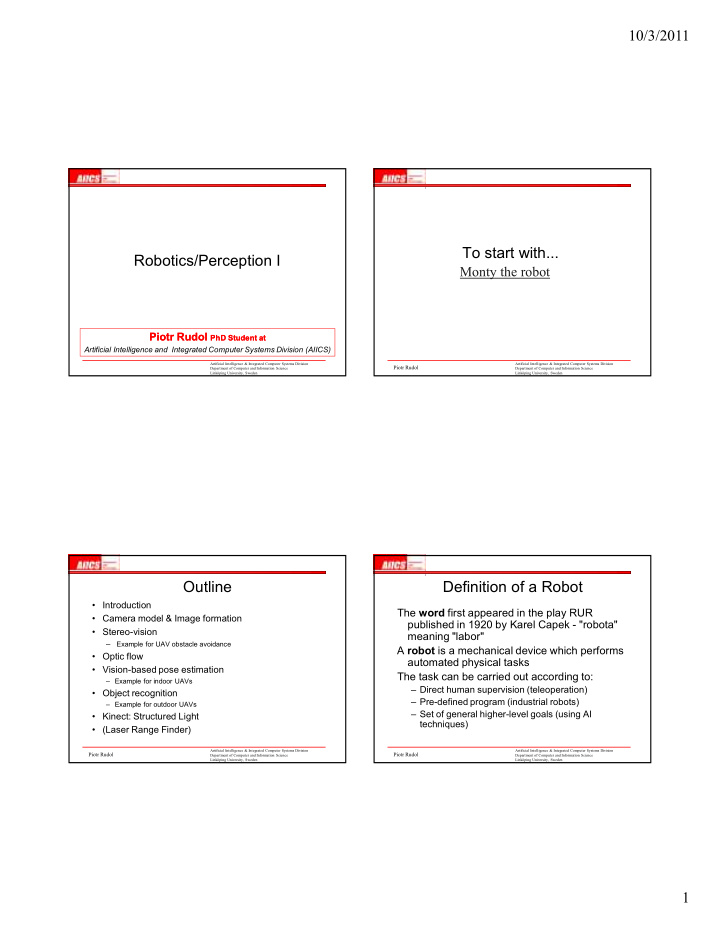



��������� To start with... Robotics/Perception I '������(����)��� ����� ����� ����� ����� �������������� �������������� ������������������������������������������������������������������������� �������������������������������������������������������������� �������������������������������������������������������������� %�����&���� ���������������������������������������������� ���������������������������������������������� � ��� !�����"���������#� �$���� ��� !�����"���������#� �$���� Outline Definition of a Robot • Introduction The ����� first appeared in the play RUR • Camera model & Image formation published in 1920 by Karel Capek "robota" • Stereo vision meaning "labor" – Example for UAV obstacle avoidance A ����� is a mechanical device which performs • Optic flow automated physical tasks • Vision based pose estimation The task can be carried out according to: – Example for indoor UAVs – Direct human supervision (teleoperation) • Object recognition – Pre defined program (industrial robots) – Example for outdoor UAVs – Set of general higher level goals (using AI • Kinect: Structured Light techniques) • (Laser Range Finder) �������������������������������������������������������������� �������������������������������������������������������������� %�����&���� %�����&���� ���������������������������������������������� � ���������������������������������������������� * ��� !�����"���������#� �$���� ��� !�����"���������#� �$���� �
��������� The First Robot Shakey Many consider the first robot in the modern sense to be a teleoperated boat, similar to a Shakey was one of the first autonomous mobile robots, built at the SRI AI Center during 1966 modern ROV (Remotely Operated Vehicle), 1972. Many techniques present in Shakey’s devised by Nikola Tesla and demonstrated at system are still under research today! an 1898 exhibition in Madison Square Garden. Based on his patent 613,809 for Video "teleautomation", Tesla hoped to develop the "wireless torpedo" into an automated weapon system for the US Navy. http://www.sri.com/about/timeline/shakey.html �������������������������������������������������������������� �������������������������������������������������������������� %�����&���� %�����&���� ���������������������������������������������� + ���������������������������������������������� , ��� !�����"���������#� �$���� ��� !�����"���������#� �$���� Why we use robots Why is (AI) robotics hard? The DDD rule: • Real life robots have to operate in unknown .���/"0�1 ���2 Dangerous, Dirty, and Dull dynamic environments Some usage areas: • It is a multi disciplinary domain from – Industry mechanics to philosophy... – Search and Rescue • It involves many practical problems: – Space Exploration – it is very technical, – Military – it takes a long time from an idea to a built system, – Research – debugging can be difficult, – Entertainment – expensive. – .... �������������������������������������������������������������� �������������������������������������������������������������� %�����&���� %�����&���� ���������������������������������������������� - ���������������������������������������������� 3 ��� !�����"���������#� �$���� ��� !�����"���������#� �$���� �
��������� Three categories of robots Anatomy of Robots Industrial robots: Robots consist of: – Mostly stationary • Motion mechanism – Some mobile used for transportation – Wheels, belts, legs, propellers Mobile robots: • Manipulators – Ground robots (UGV – legged/wheeled – NEW 180kg/30km) – Aerial (UAV – rotor craft – fixed wing) – Arms, grippers – (Under) water (AUV) • Sensors – Space • Computer systems Humanoids: – Microcontrollers, embedded computers – running, climbing stairs, Dexter walks, Dexter jumps �������������������������������������������������������������� �������������������������������������������������������������� %�����&���� %�����&���� ���������������������������������������������� 4 ���������������������������������������������� �� ��� !�����"���������#� �$���� ��� !�����"���������#� �$���� Perception Proprioceptive Sensors In order for the robots to act in the environment Inform robot about its internal state. a suite of sensors is necessary. • Shaft encoders – Odometry (measurement of traveled distance) Two types of sensors: – Positions of arm joints • Active • Inertial sensors – Emit energy (sound/light) and measure how much – Gyroscope (attitude angles: speed of rotation) of it comes back or/and with how large delay. – Accelerometers • Passive • Magnetic – Compass – Just observers, measuring energy “emitted” by the • Force sensors environment. – Torque measurement (how hard is the grip, how heavy is the object) �������������������������������������������������������������� �������������������������������������������������������������� %�����&���� %�����&���� ���������������������������������������������� �� ���������������������������������������������� �� ��� !�����"���������#� �$���� ��� !�����"���������#� �$���� �
Recommend
More recommend